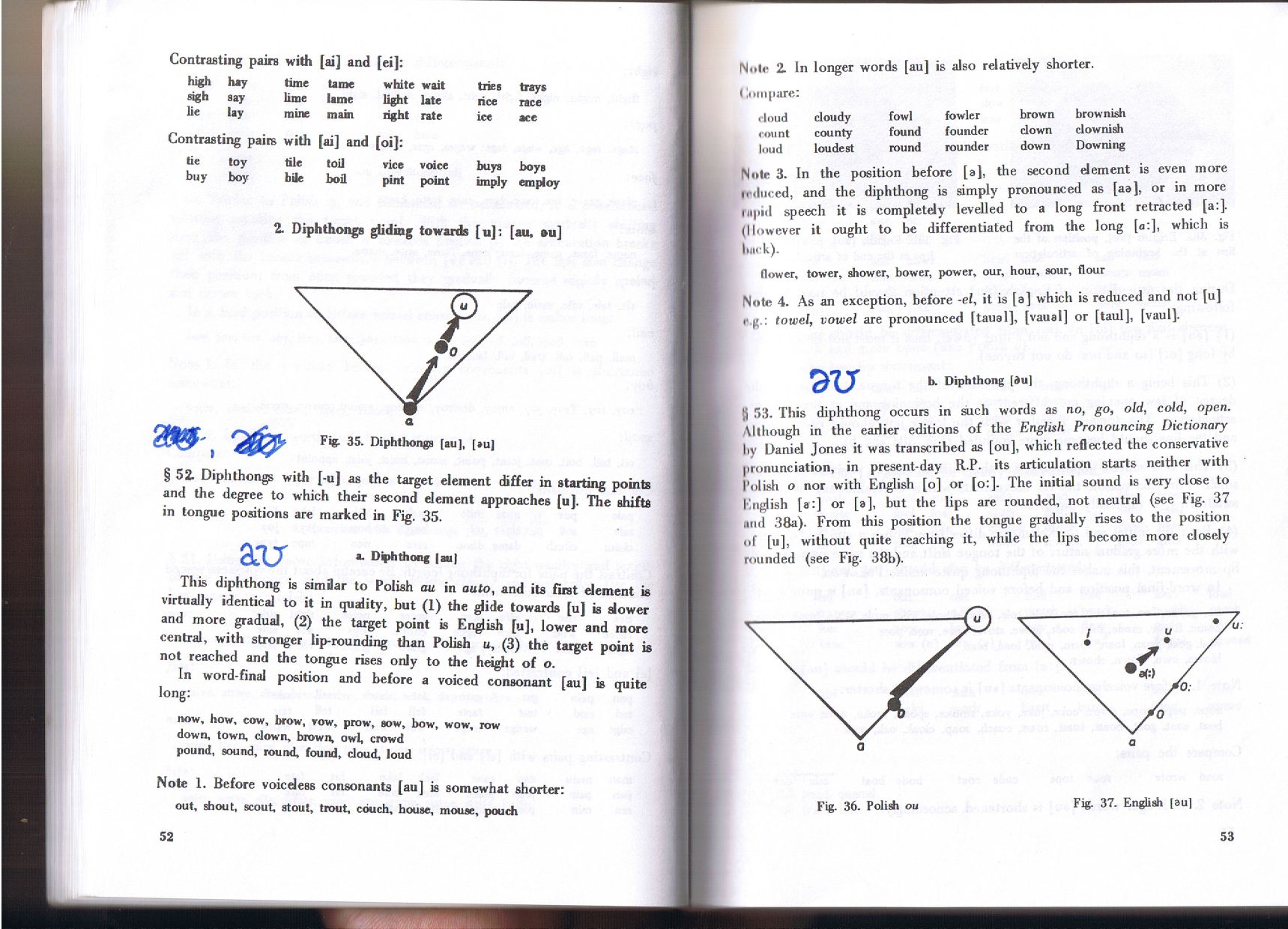CCF20100223�015

|
Contrasting pairs |
with |
[ai] and |
[«]: | ||||
|
high |
hay |
time |
tamę |
white |
wait |
tries |
trays |
|
sigh |
say |
limę |
light |
Ute |
rice |
race | |
|
be |
Uy |
minę |
mam |
ńght |
ratę |
ice |
ace |
|
Contrasting pairs |
with |
[ai] and |
[°ij: | ||||
|
tie |
toy |
tile |
toil |
vice |
voice |
buya |
boye |
|
buy |
bile |
bod |
p“ |
point |
imply |
employ | |
|
2. Diphthongs |
gliding |
towards [n]; | |
[au, »u] | ||||

t Fi& 35- DiPh,h°n«a [«•]. i»ui
§ 52. Diphthongs with [-u] as the target element differ in starting points and the degree to which their second element approaches [u]. The shifts in tongue positions are marked in Fig. 35.
Diphthong |au|
This diphthong is sim3ar to Polish au in auto, and its firet element is virtually identical to it in ąuality, but (1) the glide towards [u] is slower and morę gradual, (2) the target point is English [u], lower and morę central, with stronger lip-rounding than Polish u, (3) the target point is not reached and the tongue rises only to the height of o.
In word-final position and before a voiced consonant [au] is quite long:
now, how, cow, brow, row, praw, sow, bow, wow, row down, town, down, brown, owi, crowd pound, sound, round, found, doud, loud
Notę 1. Before yoiceless consonants [au] is somewhat shorter: out, shout, scout stout, trout, cóuch, house, mouse, pouch
Nolr 2. In longer words [au] is also relatiyely shorter.
doud doudy fowl fowler brown brownish
eount county found foundcr down downish
luud loudest round roundcr down Downing
Notę 3. In the position before [a], the second element is even morę rmluced, and the diphthong is simply pronounced as [aa], or in morę P inpiil speech it is completely level]ed to a long front retracted [a:]. (llowever it ought to be differentiated from the long [o:], which is
huck).
(lower, tower, show er, bower, power, our, hour, sour, flour Notę 4. As an exception, before -el, it is [a] which is reduced and not [u] n.g.: Iowel, vowel are pronounced [taual], [vausl] or [taul], [vaul].

O 53. This diphtliong occurs in such words as no, go, old, cold, open. Although in the earlier editions of the English Pronouncing Dictionary hy Daniel Jones it was transcribed as [ou], which reflected the conservative pronunciation, in present-day R.P. its articulation starts neitlier with Polish o nor with English [o] or [o:]. The initial sound is very close to English [a:] or [a], but the lips are rounded, not neutral (see Fig. 37 mul 38a). From this position the tongue gradually rises to the position of [u], without quite reaching it, while the lips become morę closely rounded (see Fig. 38b).

a
Fig. 37. English [au]
a
Fig. 36. Polish ou
53
Wyszukiwarka
Podobne podstrony:
CCF20100223�015 Contrasting pairs with [ai] and
CCF20100223�006 Worda with [ju:]: musc, musie, lunę, lunie, cube, cubic, due, duty, new, newest, Hun
CCF20110611�027 at fast with researchers who have at least some idea of the enormous cornpiexity of
CCF20110401�003 Gradable and ungradable adjectives 1 a Complete the table below with pairs of adject
tional ąuestion" ought to be formulated, by contrast with the 18* and 19* century question of t
V 198 Arquivos is generally situated in its middle-right region, in contrast with
Idealism Idealism. Bcpeóence is ultimateły based on mentai activity. It is contrasted with realism.
CCF20100119�018 r ui^icąkkj n ots1iale-^ 1 ^ ; i rr f......n......s......r ai ptrti j . P ! i i ! i
CCF20100621�010 O&pćn .JWp-y/ai^a, h^Uco tolae ^-a£*-1 k±ł5n^Ov u^t^u^w
CCF20101202�000 ENGL1SH TONES. TONĘ UNI I S with Ihe TONIC preceded by a monosyllabic unstressed PRE
CCF20101202�002 THE PRONUNCIATION OF THE SENTENCE, lb (from RK) WITH RHYTHM AND INTONATON ANALYSE AN
CCF20110611�059 Criterion-Referenced Test: A test in Which the performance of an individual is
CCF20110611�063 Which data do you think a syllabus designer with a prócess orientation might focus o
CCF20120401�08 Województwo Łódzkie :: Stan zdrowia Strona 1 z 3 Urząd Marszałkowski w Łodzi, ai. P
CCF20121127�000 $ ? ?fl ,?Ai Jrrp£ y- j_ __i/j
CCF20100120�003 *02/? le A ? ■ MroMa, 1 d <C pu n bf- / i (4) odolaLoone od s¥i<°bi
więcej podobnych podstron